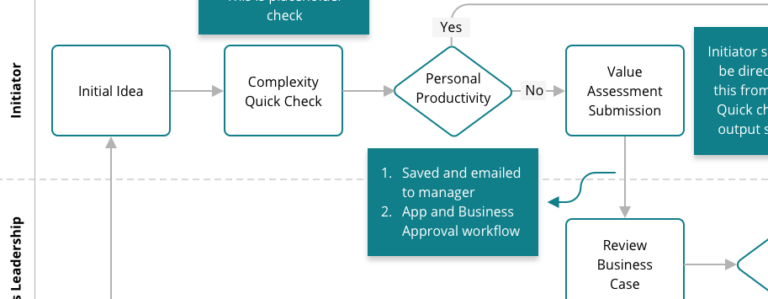How can you identify and develop your Microsoft Power Platform processes to support strong organizational governance and ensure you reach your goals?
Microsoft Power Platform is an accessible, low-code toolset that enables people across your organization to create apps or other types of solutions to business challenges. However, ungoverned use of the platform may pose a risk to your organizational information and processes.
In the first article in this series, People and Governance, we explored the individuals in your organization who may use Microsoft Power Platform and the roles they play in governing the use of the platform. In this next article, we will examine the second pillar of a successful governance structure — processes.
How processes support good governance
A process is an ordered group of activities that achieve an organizational goal. It can be broken down into a series of actions or steps that direct how work is completed within an organization to be successful. It will often involve multiple stakeholders, who each execute specific tasks at defined steps in the process.
Processes ensure that the correct teams are involved, reviews and approvals are carried out, status is recorded, and results are obtained consistently. Processes help your operations run efficiently even if a team member is away on vacation or a new employee is following the process for the first time. Appropriate, well-defined processes reduce risks to your organization and help ensure it operates effectively.
Successful organizations identify significant activities and then define related key processes, such as how to test and deploy an IT system or how to perform staff onboarding or offboarding. Well-defined processes contribute to reliable and repeatable outcomes for the organization.
Processes also reduce risks and enforce consistency — which makes process identification and improvement an essential part of your Microsoft Power Platform governance structure.
How to identify in-scope processes
Identifying and developing relevant processes can be a complex task — and you may not be sure where to get started. During the process identification stage for Microsoft Power Platform, it may be helpful to review your high-level goals first. After you review your goals, you can then define the process supporting those goals.
Example of high-level goals may include:
- Enabling citizen developers
- Streamlining the review, approval, and development of ideas
- Sustaining deployed solutions
The processes supporting these goals may be written as:
- Citizen developer enablement
- Solution development (ideation through to deployment)
- Solution sustainment
It is important to note that new processes should only be created when necessary. If relevant, strong processes already exist within your organization, consider how your Microsoft Power Platform activities can be adapted and aligned with those processes.
Existing processes are already defined, have organizational support, and are in use within your organization. Some changes may be required to existing processes to accommodate the specific needs of Microsoft Power Platform. You may also need to adapt your desired Microsoft Power Platform activities to meet organizational process requirements.
Identifying processes that are weaker or undefined within your organization typically require increased analysis time. Smaller or narrow-focused processes can be defined by an activities-identification discussion with your dedicated Centre of Excellence team.
These narrow-focused processes may include items such as:
- New environment requests
- Security group change requests
- DLP policy change requests
After you identify processes for Microsoft Power Platform at the highest level, the next step is to add detail to each process. One approach is process flow development. Your Centre of Excellence team can begin process flow development as soon as the processes are identified and the decision to create new processes or align with existing organizational processes has been made. This helps streamline tasks and ensures strong governance throughout the steps of each process.
What is involved in process flow development?
Representing processes through visual tools is a useful method to support collaboration. Selecting a graphical tool capable of representing swim lanes can help participants understand the process stages and support the development of new processes. A visual tool that supports easy updates during discussions can also help encourage lively collaboration with immediate, tangible, and unambiguous results.
Below is an example of how to visualize a process flow:

After a desired process flow is detailed at a high level, various steps and decision points can be defined even further. These decision points may include determining which actions and handoffs are completed manually, where automation development is necessary, and which systems may need to be integrated to streamline workflow.
Identifying desired processes will allow for comparison between current and future states and will help enable roadmap development. It can also help identify where involvement from other teams will be required to ensure successful process improvement and governance. The goal of this approach is to iterate and discuss so that processes can be defined, refined, and improved.
Some process-defining tips include:
- Identify the goal or outcome
- Identify process scope (what action starts the process and what action ends the process)
- Identify activities
- Identify the stakeholders (the doers, reviewers, approvers, etc.)
- Order activities, assigning them to stakeholder lanes
- Select tools that support collaborative discussion
- Iterate — this will take time to complete and may change over time
Well-defined processes play an essential role in both using and governing Microsoft Power Platform successfully. A thorough understanding of each process is necessary before your organization can investigate the supporting tools that will enable both your people and processes to reach their goals on the platform.
Connect with us to get started
Our team of dedicated professionals can help you determine which options are best for you and how adopting these kinds of solutions could transform the way your organization works. For more information, and for extra support along the way, contact our team.
